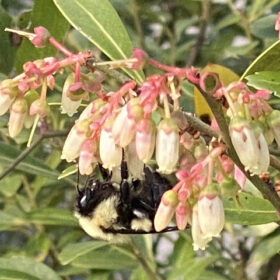By Pat Foster-Turley
March 3, 2023
Sometimes when Bucko and I are bored with Amelia Island’s natural sights, we head to the nearby Okefenokee Swamp National Wildlife Refuge looking for more excitement. It’s only a bit more than an hour’s drive up to this refuge just south of Folkston, Georgia and if you take Highway 17 north, Route 108 west, and Highway 301 north, it’s an interesting drive through the back areas of Nassau County.

Once you get to the refuge there are a number of options to enjoy your visit. You can ride on a boat up a canal while a guide points out alligators, birds, flowering plants and other natural sights. If you are more energetic and adventurous you can rent a kayak and do the same route yourself, with interesting side trips into the swamp. You can linger in the air-conditioned visitor center, watch an informative introductory movie and learn from the exhibits. You can hike on a number of trails along the fringe of the swamp and climb up an observation tower to get a bird’s eye view. You can visit the old Chesser Island Homestead and get a glimpse of pioneer life in the swamp, and if you time it right you can talk to reenactors who volunteer some weekends to tell you more.

Or, like Bucko and I often do, you can just take a leisurely drive along a five-mile loop trail and see what you can see. You need patience and good observation skills to make the most of this drive but there is always something interesting to see.
On a recent drive along the loop road, Bucko and I stopped at our favorite spots and looked more closely. We stopped first at the parking area beside the borrow pit pond on the right side of the road. Sure enough, there were alligators in the pond—a mama gator and some of her offspring were sunning on the central island there. But that wasn’t all. Along the edge of the pond native blueberries were blooming and large black and yellow bumble bees were feasting on the nectar. Splendid.
Across the road from this pond, there is one tall pine tree marked with a white band and an aluminum label with the number 92, and, looking upwards, there is a hole in the tree, a nesting cavity for a group of endangered red-cockaded woodpeckers. Emanating from this hole is a trail of years of dried sap running down the trunk. These birds peck at the bark until pitch is released, which purportedly deters snakes from climbing up to eat the nest contents. Looking around from this tree you can see many other trees with white bands marking other nests that are part of a long-term study.

We cruise slowly from this point onwards, keeping a close eye on the ditch along the left side of the road. Carnivorous pitcher plants and wildflowers often decorate the side of the ditch, and we usually see alligators, turtles, and, if we are lucky, maybe even an otter swimming in the ditch. At the midpoint in the loop road, there is a large parking lot with restrooms and an inviting boardwalk leading to an observation tower where you can scan the swamp from above.
The scenery around this boardwalk changed dramatically a few years ago when most of the trees and the boardwalk itself were burnt up in a fire. The boardwalk has now been rebuilt, complete with pipes that can water the boardwalk in case of another fire. But the trees will take longer to return, and much of the walk is open prairie – very hot in summer.

But still, there are sights to see along this walk. It is always a wonder to admire the bald cypress trees with their knees popping up all around and their branches draped with Spanish moss at the start of the boardwalk. You have to be careful, though, as there are often large white blotches on the boardwalk deposited from birds flying overhead. Often flowers bloom along the edge of the path, and sometimes you can spot frogs in the water. Always fun, at least for me, is interaction with the few other visitors there. This past visit I enjoyed talking to a kid carrying a net who was looking for frogs to catch and release.

We never know what we will see when we take the short drive to the Okefenokee National Wildlife Refuge, but it is never time wasted. Check it out yourself and go soon, before the heat and bugs of summer take over. And have fun!
Pat Foster-Turley, Ph.D., is a zoologist on Amelia Island. She welcomes your nature questions and observations. [email protected]

I look forward to Pat’s column every Friday. We’re new to northern florida and learn so much each week. Thanks Pat
Thanks for sharing your adventure to the Okefenokee Ms. Pat. I have always enjoyed visiting there and hope that the proposed mining project fails to materialize.